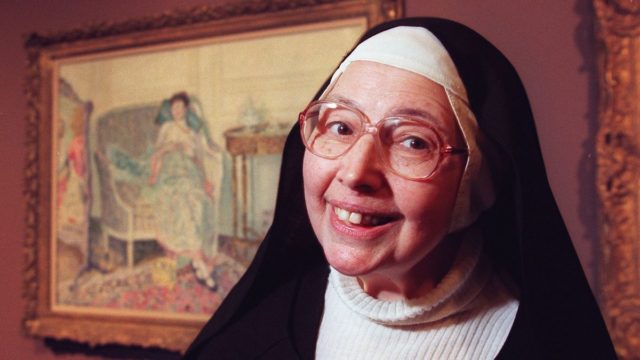Sister Wendy Beckett, recently died aged 88, could be dismissive of the high-profile television work that made this hermit nun with owl-like glasses into an unlikely household name during the 1990s.
“If I had known how much time it would take, I would never have started it.” She was an iconic lady. She communicated to millions of people her love of Art. A love that brought appreciation of beauty to millions of viewers on her popular TV shows.
Wendy was born in Johannesburg to Aubrey and Dorothy Beckett. She never liked her Catholic parents’ choice of name.
“It’s a trivial little name. I think Mother called me Wendy because she thought I would be small and pretty.
She was probably rather taken aback when she got this lump of a child who did nothing but read.”
She spent part of her childhood in Edinburgh, where her father trained to be a doctor before returning to South Africa.
She was, by her own account, a frail girl. Had she been worldlier, she used to reflect, she would never have joined the Notre Dame de Namur sisters – the order that ran her own school – because she was physically unsuited to the rigours of classroom teaching.
After graduating in style, however, she soldiered on for 17 years in convent schools in South Africa, feeling she had no alternative, until finally her health collapsed.
Her order agreed to her living thereafter under the protection of the Carmelites in Norfolk as a hermit, devoting herself to prayer.
She was received by the local bishop as a consecrated virgin, an ancient ceremony, revived in Catholicism in the 1970s, in which she pledged her perpetual virginity and was “betrothed mystically to Christ”.
She dressed not as a Carmelite, but in a traditional black and white habit that she designed herself, merging features from several orders.
Her caravan in the grounds of the Carmel was small, cold and basic, but was crammed with postcards and calendars of works of art.
Starting in the early 80s, she began to put down on paper – often in close type, squeezed onto the back of a recycled luggage label – her thoughts about paintings that she had only ever seen in reproduction.
A visitor to the Carmel, the cook and devout Catholic Delia Smith, was so impressed by Sister Wendy’s writing that in the late 80s she persuaded the Catholic Herald newspaper to publish them as a weekly series.
It led in turn to an appearance on a TV arts show and eventually to five major series, scripted and presented by “one-take-Wendy”, as she was known to directors.
Her impact on audiences was so great that she even had a musical written about her.
‘Postcards from God: The Sister Wendy Musical’, created by Marcus Reeves, ran briefly and camply in a small West End venue. Sister Wendy herself said she was bemused but not displeased by the accolade.
Her health was never good – she had suffered from a weak heart since childhood – and could very quickly run out of energy in mid-take.
After Sister Wendy’s American Collection and Sister Wendy at the Norton Simon Museum had made her name with US TV viewers in 2001-02, she declined any further offers.
Her novelty may have also worn off for commissioners in Britain, for her subsequent attempt to return to our screens to present a short series on Orthodox icons, a great passion, failed to find a taker.
Her routine in the caravan was both simple and extraordinary. She would get up at 1am, the best time for prayer and contemplation, she said.
She would find time for a couple of hours of work, writing the occasional article and a series of well-received books on prayer, St Paul and the religious festivals.
At some stage, she would walk over to the Carmel to collect food and her post and then turn in for the night at 6pm.
She communicated with the Carmelites only by note and lived, for the most part, alone and in total silence. It was as she wanted it.
Behind her gentle, toothy smile, though, Sister Wendy could be fierce. It was seen in some of her verdicts on modern artists who failed to interest her, though cloaked as ever in a show of nun-like Christian charity.
“I find myself saying to myself firmly that I might not have been interested or excited or challenged by what I’ve seen,” she said on a rare trip to London in 2008 to see an exhibition by those on the Turner Prize shortlist.
“But the artists who made these installations must have been. I am prepared to marvel at their inexplicable enthusiasm.”
Her own preferences among the current generation featured figurative and often religious painters such as Greg Tricker, Simon Garden and James Gillick.
Her steel could also be glimpsed in relation to what she insisted was her own ‘very minor celebrity’.
When approached, during a trip to a London gallery, by a fan who wanted to get into contact with her about a personal problem, Sister Wendy smiled kindly but, once the woman had gone, remarked, “I hope that woman doesn’t write to me. My time is for God. I’ve no time for gardening and letter-writing, the usual let-outs for those who are alone.”
Despite her old-fashioned garb, her views on Catholicism were anything but traditional.
In private – and occasionally in public – she would question the church’s strict code on sexual ethics as a distraction from the real business of bringing people to God, whatever their gender, chosen method of contraception or orientation.
And her views on God were challenging. When asked once what she felt about God, she replied, sharply: “I don’t think anyone can feel God. Those who believe in him most are most aware of his non-feelability, as it were. God is such a total mystery. My heart sinks when the word God is bandied around glibly.”
SEE ALSO – Fr Paddy: Direct provision centres have no place God’s Kingdom























